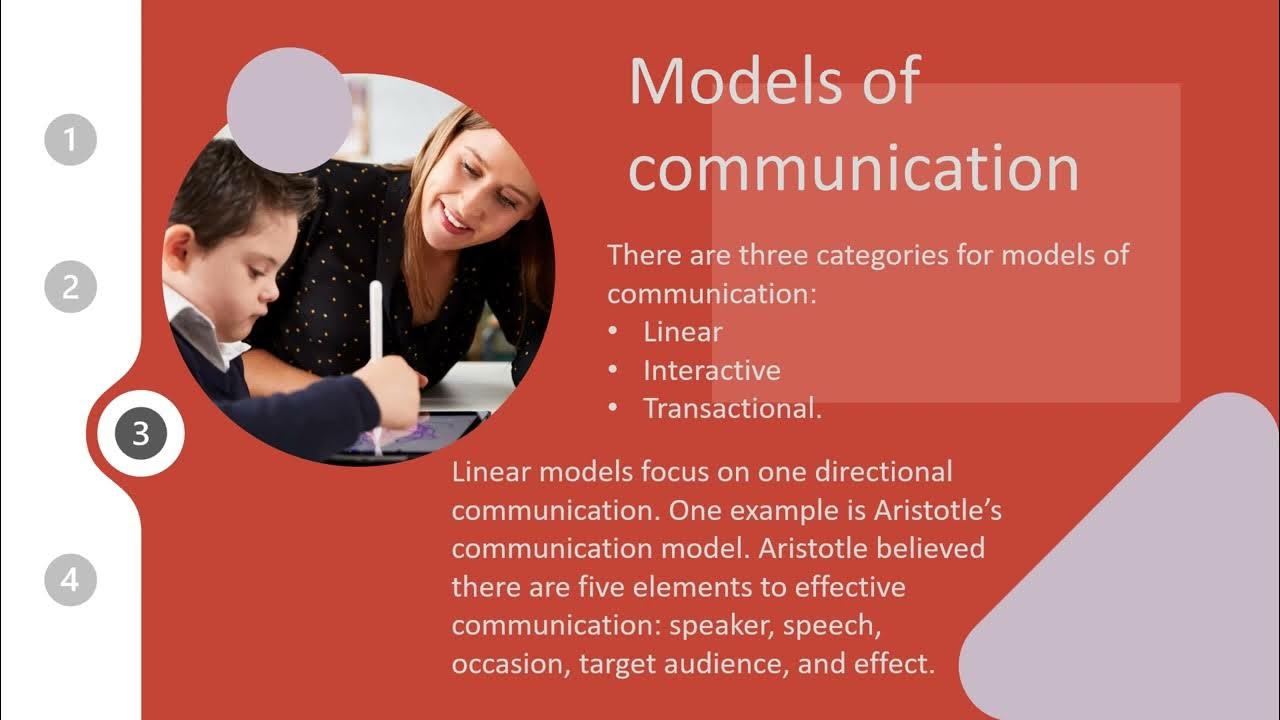The 3 Models of Communication
Summary
TLDRThis virtual lecture delves into the three fundamental models of communication: the Linear, Interactive, and Transactional Models. The Linear Model outlines the basic process of encoding, sending, and decoding messages, while acknowledging the impact of noise. The Interactive Model expands on this by incorporating feedback and environmental influences. The Transactional Model further refines the concept by emphasizing the dual roles of individuals as both senders and receivers in communication, highlighting the dynamic and reciprocal nature of human interaction.
Takeaways
- 📚 Communication is defined as the process of sending and receiving messages to create shared meaning.
- 📈 The Linear Model is the initial attempt to explain the communication process, involving encoding, sending, and decoding messages through various channels.
- 🔍 The Linear Model recognizes the impact of physical and psychological noise on the encoding and decoding of messages.
- 🔄 The Interactive Model builds upon the Linear Model by incorporating feedback from the receiver through verbal and nonverbal responses.
- 🌐 The Interactive Model acknowledges that communication can be influenced by the environment or context in which it takes place.
- 🔄 The Transactional Model introduces the idea that individuals can be both the source and receiver of communication, often simultaneously.
- 🤝 The Transactional Model emphasizes the reciprocal nature of communication, where roles can be interchangeable.
- 🔑 Each model of communication has evolved to better capture the complexity of human interaction.
- 📝 The models highlight the importance of understanding the roles of encoding, decoding, feedback, and context in effective communication.
- 🌟 The script aims to enhance the understanding of how human communication functions through the lens of these three models.
- 👋 The virtual lecture concludes by expressing gratitude for the audience's participation and hoping to have provided clarity on communication models.
Q & A
What is the definition of communication mentioned in the script?
-Communication is defined as the sending and receiving of messages to create shared meaning.
What is the Linear Model of communication?
-The Linear Model of communication is the first attempt at explaining how communication works, involving a source encoding a message, sending it through a channel to a receiver who then decodes it, with noise affecting both encoding and decoding.
What are the key elements missing in the Linear Model according to the script?
-The Linear Model is missing the feedback process and the influence of the environment or context on communication.
How does the Interactive Model differ from the Linear Model?
-The Interactive Model includes the feedback from the receiver through verbal and nonverbal responses, and acknowledges the influence of the environment on communication.
What is the main feature of the Transactional Model of communication?
-The Transactional Model emphasizes that each individual takes turns being both the source and the receiver, and sometimes acts as both simultaneously.
How does noise affect the communication process in the Linear Model?
-Noise in the Linear Model affects how messages are encoded and decoded, potentially leading to miscommunication.
What role does feedback play in the Interactive Model?
-Feedback in the Interactive Model allows the receiver to respond to the message, which can influence the source's subsequent messages.
Can you explain the concept of 'source encoding' in the context of the Linear Model?
-Source encoding in the Linear Model refers to the process of taking an idea and giving it meaning through words or symbols before sending it to the receiver.
What is 'decoding' in the context of communication models?
-Decoding is the process by which the receiver interprets the meaning from the message sent by the source.
How does the environment or context influence communication according to the Interactive Model?
-The environment or context can influence communication by affecting the interpretation of messages and the effectiveness of encoding and decoding.
What does the Transactional Model add to our understanding of communication that the other models do not?
-The Transactional Model adds the understanding that communication is a reciprocal and simultaneous process where roles of source and receiver can be shared or interchangeable.
Outlines

هذا القسم متوفر فقط للمشتركين. يرجى الترقية للوصول إلى هذه الميزة.
قم بالترقية الآنMindmap

هذا القسم متوفر فقط للمشتركين. يرجى الترقية للوصول إلى هذه الميزة.
قم بالترقية الآنKeywords

هذا القسم متوفر فقط للمشتركين. يرجى الترقية للوصول إلى هذه الميزة.
قم بالترقية الآنHighlights

هذا القسم متوفر فقط للمشتركين. يرجى الترقية للوصول إلى هذه الميزة.
قم بالترقية الآنTranscripts

هذا القسم متوفر فقط للمشتركين. يرجى الترقية للوصول إلى هذه الميزة.
قم بالترقية الآن5.0 / 5 (0 votes)






